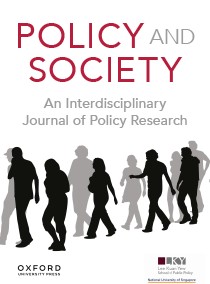“New normal” at work in a post-COVID world: work–life balance and labor markets
IF 5.7
1区 社会学
Q1 POLITICAL SCIENCE
引用次数: 64
Abstract
The coronavirus pandemic has interrupted labor markets, triggering massive and instant series of experimentations with flexible work arrangements, and new relationships to centralized working environments. These approaches have laid the basis for the “new normal,” likely extending into the organization of work in the post-pandemic era. These new arrangements, especially flexible work arrangements, have challenged traditional relationships with employees and employers, work time and working hours, the work–life balance (WLB), and the relationship of individuals to work. This paper investigates how labor markets have been interrupted due to the pandemic, focusing especially on manual (blue-collar) and nonmanual (white-collar) work and the future of the WLB, along with exploring the projected deviations that are driving a foreseeable future policy revolution in work and employment. This paper argues that although hybrid and remote working would be more popular in the post-pandemic for nonmanual work, it will not be “one size fits all” solution. Traditional work practices will remain, and offices will not completely disappear. Manual labor will continue current work practices with increased demands. Employers’ attention to employees’ WLB in the new normal will target employees’ motivation and achieving better WLB. These trends for the labor market and WLB are classified into three categories—those that are predicated on changes that were already underway but were accelerated with arrival of the pandemic (“acceleration”); those that represent normalization of what were once considered avant-garde ways of work (“normalization”); and those that represent modification or alteration of pre-pandemic set-up (“remodelling”).后疫情时代的“新常态”:工作与生活的平衡和劳动力市场
冠状病毒大流行中断了劳动力市场,引发了一系列大规模的、即时的灵活工作安排试验,以及与集中工作环境的新关系。这些方法为“新常态”奠定了基础,可能延伸到大流行后时代的工作组织。这些新的安排,特别是灵活的工作安排,挑战了员工和雇主之间的传统关系,工作时间和工作时间,工作与生活的平衡(WLB),以及个人与工作的关系。本文调查了劳动力市场是如何因疫情而中断的,特别关注体力(蓝领)和非体力(白领)工作以及WLB的未来,同时探讨了推动可预见的未来工作和就业政策革命的预测偏差。本文认为,尽管混合和远程工作将在大流行后的非体力工作中更受欢迎,但它不会是“一刀切”的解决方案。传统的工作方式将会保留,办公室也不会完全消失。随着需求的增加,体力劳动将继续目前的工作方式。在新常态下,雇主对员工工作负载的关注将针对员工的动机,实现更好的工作负载。劳动力市场和劳动生产率的这些趋势分为三类:一类是基于已经在进行的变化,但随着大流行的到来而加速的变化(“加速”);那些代表着曾经被认为是前卫工作方式的正常化(“正常化”);以及那些代表大流行前设置的修改或改变(“重塑”)。
本文章由计算机程序翻译,如有差异,请以英文原文为准。
求助全文
约1分钟内获得全文
求助全文
来源期刊

Policy and Society
Multiple-
CiteScore
18.00
自引率
6.50%
发文量
43
审稿时长
30 weeks
期刊介绍:
Policy and Society is a prominent international open-access journal publishing peer-reviewed research on critical issues in policy theory and practice across local, national, and international levels. The journal seeks to comprehend the origin, functioning, and implications of policies within broader political, social, and economic contexts. It publishes themed issues regularly and, starting in 2023, will also feature non-themed individual submissions.
 求助内容:
求助内容: 应助结果提醒方式:
应助结果提醒方式:


